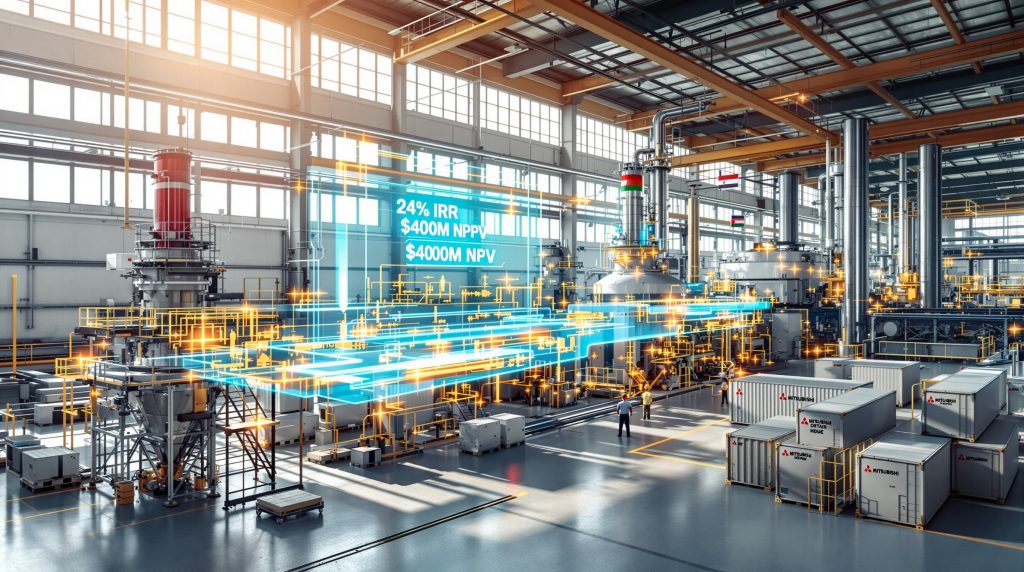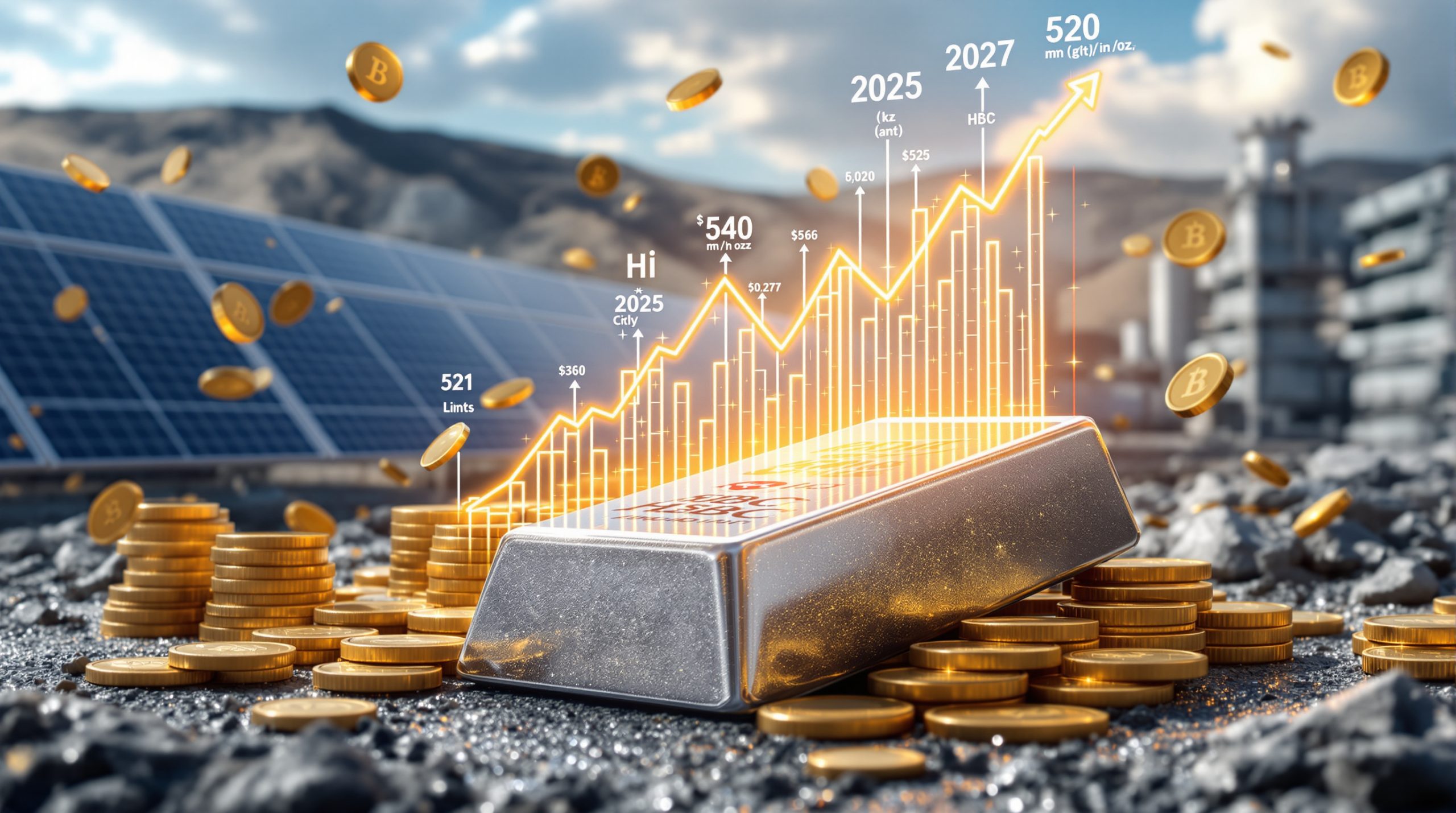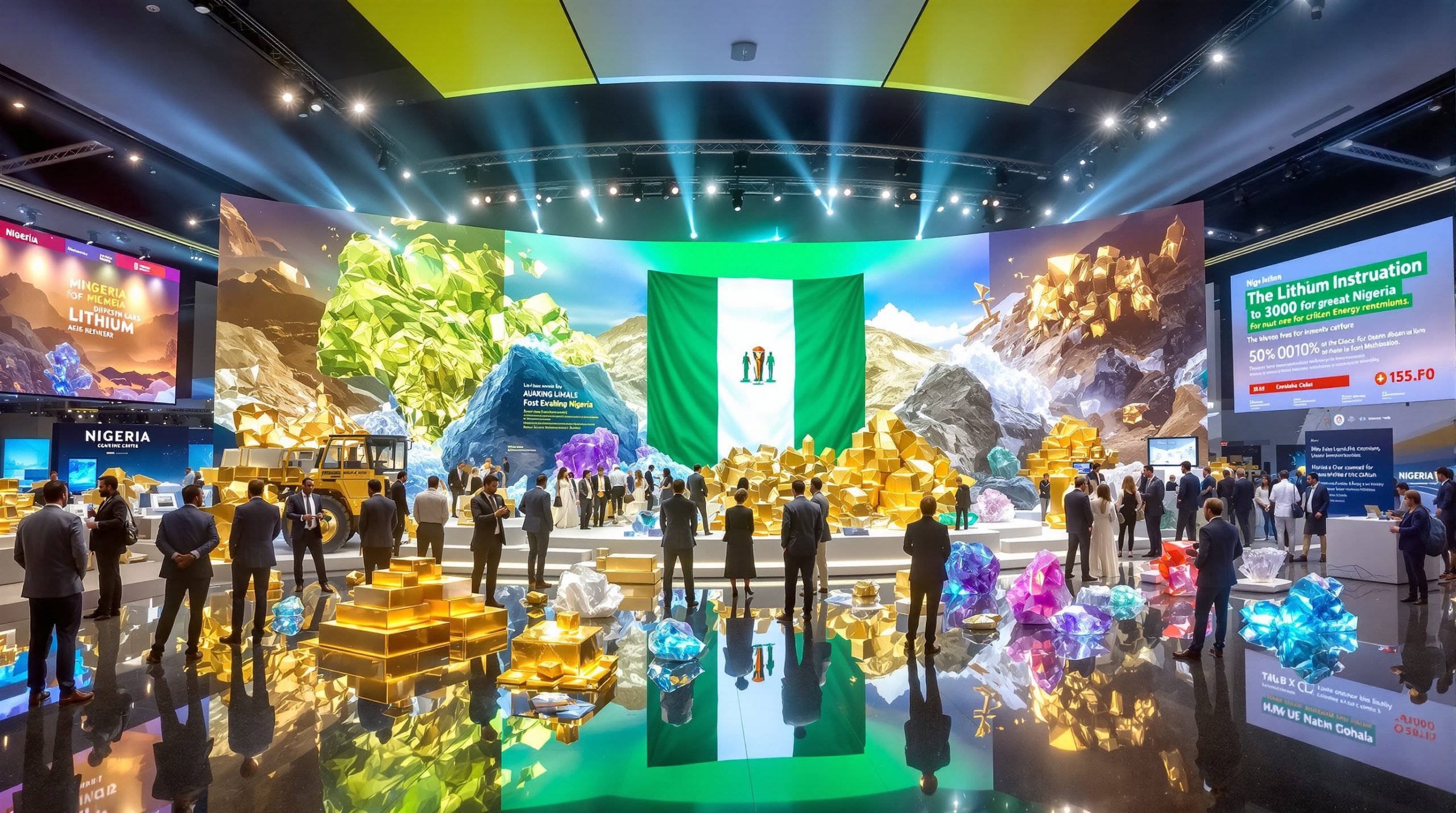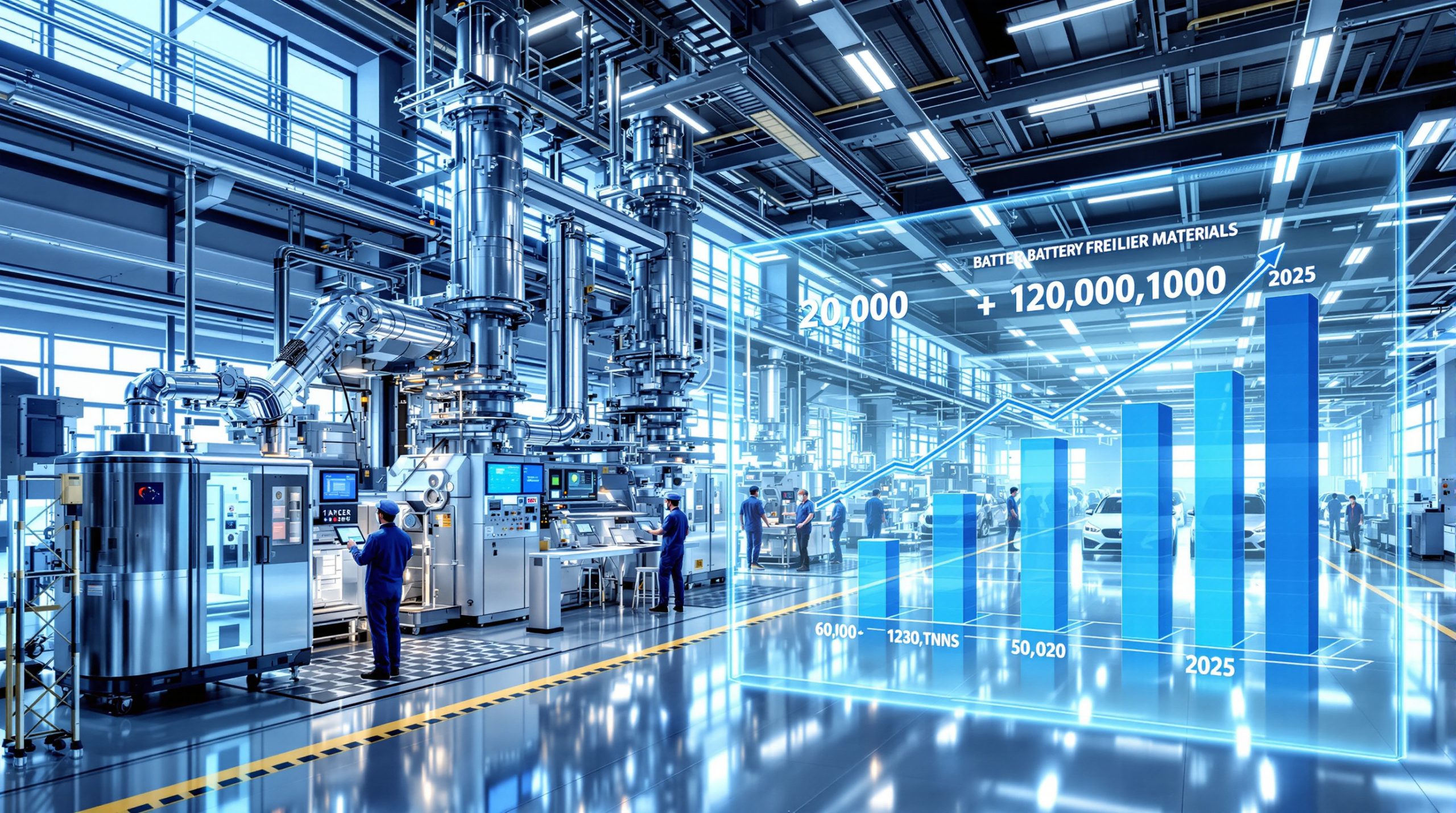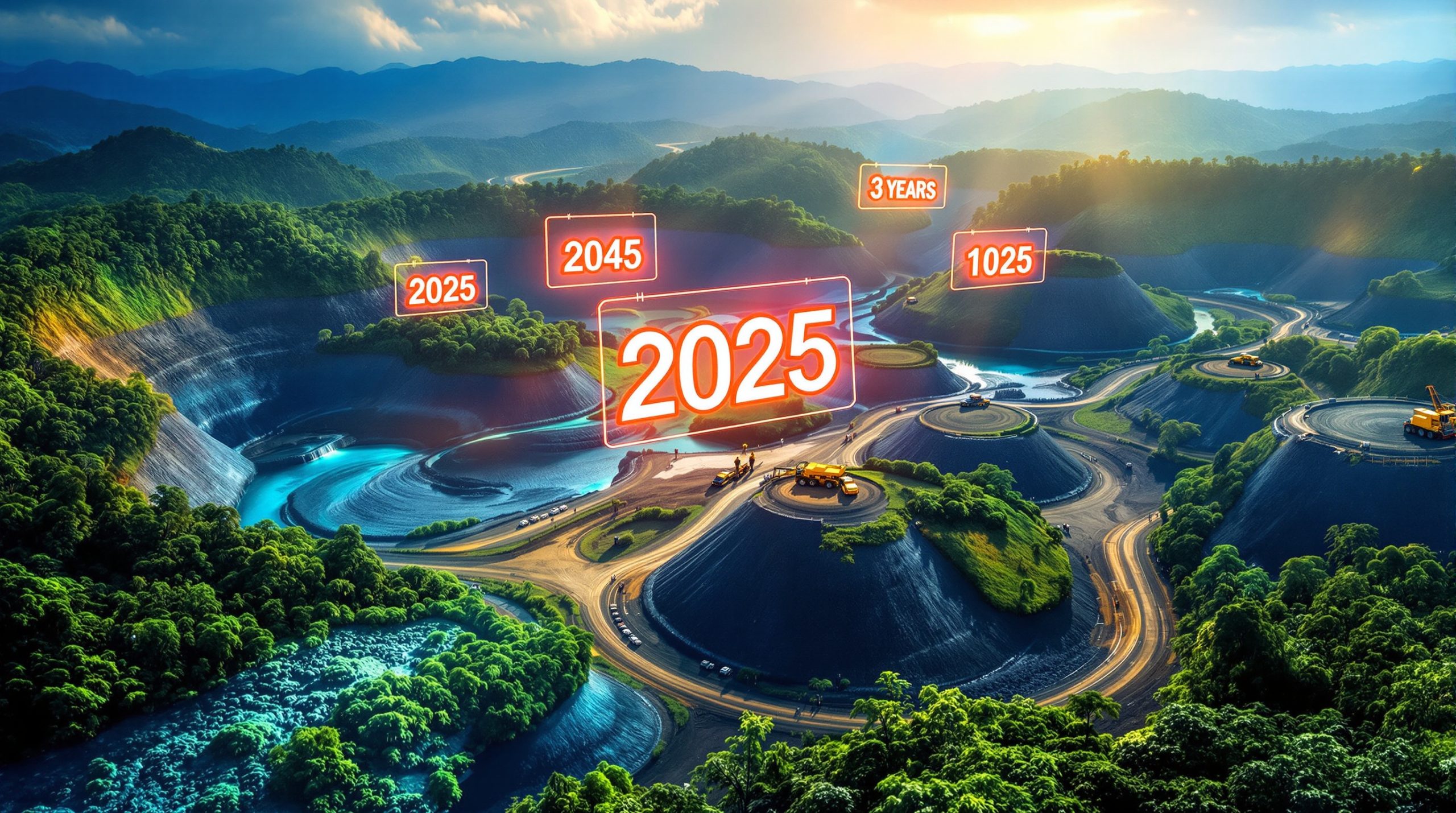Strategic Significance of NextSource Materials' Abu Dhabi Anode Project
The graphite industry is experiencing a transformative shift as NextSource Materials advances its innovative Abu Dhabi anode project. This strategic initiative represents a significant move to establish substantial battery material production capacity outside traditional supply chains, addressing the growing global demand for critical components in electric vehicles and grid-scale energy storage systems.
Breaking China's Dominance in the Battery Anode Supply Chain
For decades, China has maintained an overwhelming dominance in the battery anode materials sector, controlling approximately 90% of global natural graphite anode material production capacity according to Benchmark Mineral Intelligence. This concentration has created vulnerability in global supply chains, particularly as electric vehicle production accelerates worldwide.
The Abu Dhabi facility represents one of the most significant attempts to diversify this critical supply chain. By establishing what NextSource describes as "one of the leading, if not the biggest, non-Chinese producers of active anode material," the project directly addresses concerns about supply security for Western automotive manufacturers and battery producers.
Industry analysts have highlighted that this diversification is arriving at a crucial time. The International Energy Agency's Critical Minerals Market Review notes that only about 5% of anode material production capacity exists outside China, creating a strategic opportunity for well-positioned projects like NextSource's Abu Dhabi facility.
Vertical Integration from Madagascar Graphite to UAE Processing
A distinguishing characteristic of NextSource's strategy is its vertical integration approach. Unlike competitors who often rely on third-party suppliers, NextSource controls its supply chain from mine to finished product through its Molo graphite operation in Madagascar.
The Molo mine, one of the largest and highest-quality graphite resources globally, provides NextSource with secured feedstock supply. According to the company's resource statements, the mine contains measured and indicated resources of 36.6 million tonnes at 7.68% total graphitic carbon.
This integration offers several strategic advantages. Quality control becomes more manageable throughout the supply chain, allowing NextSource to maintain consistent material specifications. The company can also tailor mine output to specific downstream requirements, creating a significant competitive edge in serving demanding customers in premium battery metals investment market segments.
Meeting Critical Demand for EV and Energy Storage Markets
The timing of NextSource's project aligns with explosive growth projections for battery materials. According to Markets and Markets Research, the global anode materials market was valued at approximately $7.9 billion in 2023 and is projected to reach $27.3 billion by 2030.
This growth is driven by accelerating electric vehicle adoption and expanding energy storage deployments. Major automotive manufacturers have announced ambitious electrification targets, with many planning to be fully electric within the next decade. Each electric vehicle requires substantial quantities of battery-grade graphite for anode production.
Additionally, grid-scale energy storage installations are growing exponentially as renewable energy penetration increases, creating further demand for high-performance battery materials. NextSource's strategic positioning in this market provides exposure to both these high-growth sectors.
How Will the Abu Dhabi Facility Transform Global Anode Production?
The establishment of NextSource's Abu Dhabi facility represents a significant shift in global anode production dynamics. This project introduces substantial non-Chinese production capacity in a market that has long been dominated by Asian suppliers.
Strategic Location Benefits in UAE's Industrial Ecosystem
The selection of Abu Dhabi as the project location provides NextSource with several distinct advantages. According to the Abu Dhabi Department of Economic Development, the emirate offers industrial electricity rates approximately 30-40% lower than European averages, significantly reducing operational costs for energy-intensive processing activities.
The regulatory environment also provides benefits, with favorable tax treatment in designated industrial zones. This creates a competitive cost structure compared to alternative locations in Western countries with higher tax burdens and regulatory compliance costs.
Access to Khalifa Port, ranked among the top 50 global container ports, provides efficient logistics connections to both source materials and end markets. This strategic positioning enables NextSource to serve international customers through established shipping lanes with minimized transit times.
The existing industrial infrastructure also accelerates the development timeline. As NextSource CEO Hanré Rossouw explained: "We found an existing building suitable for a plug-and-play setup, which will help us start production by 2026." This approach eliminates significant construction time that would be required for a greenfield development.
Production Capacity and Market Impact Analysis
The Abu Dhabi facility represents a substantial addition to global anode material production capacity outside China. While specific production targets in tonnes per annum haven't been publicly disclosed, the scale of investment indicates a significant operation.
The project's total capital expenditure of US$291 million, with US$150 million allocated to phase one, suggests a major production facility by global standards. Industry analysts note that this investment level typically corresponds to tens of thousands of tonnes of annual production capacity.
This additional capacity could meaningfully impact global supply dynamics, particularly for battery manufacturers seeking sources outside China. The U.S. Inflation Reduction Act provides tax credits for electric vehicles only if battery components, including anode materials, meet increasing domestic content requirements, creating strong incentives for supply chain diversification.
Technological Advantages of NextSource's Processing Methods
Converting natural graphite to battery-grade anode material involves a sophisticated multi-step process. According to the International Energy Agency, this typically includes crushing and milling, spheroidization, purification to achieve >99.95% carbon content, and surface coating.
While NextSource hasn't publicly disclosed specific proprietary elements of its processing methodology, the battery anode industry recognizes that achieving consistent quality specifications is critical. As Rossouw noted, "Graphite is a complex material — not a simple commodity — and the qualification process is essential."
Battery-grade graphite requires precise particle size distribution, with D50 typically measuring 15-20 microns for spherical graphite according to Fastmarkets analysis. The specific surface area must also meet stringent specifications, typically 1.5-3.0 m²/g. Meeting these requirements consistently is essential for serving demanding automotive customers.
What Financial Metrics Support the Project's Viability?
The economics of NextSource's Abu Dhabi anode project demonstrate compelling financial metrics that make it attractive to investors and strategic partners. These figures provide insight into the potential return profile and commercial viability of the venture.
Breaking Down the $291M Investment Structure
The total capital expenditure for the project is US$291 million, structured in a phased approach to manage risk and capital deployment. Phase one requires US$150 million, allowing for initial production capacity while establishing the facility's operational capabilities.
This phased development approach is significant for several reasons. First, it reduces initial capital requirements, making financing more manageable. Second, it allows for technological optimization and market validation before committing to full-scale expansion. Finally, it provides flexibility to adjust subsequent phases based on evolving market conditions and customer requirements.
According to NextSource, approximately half of the required equipment for the project has already been ordered and is currently stored in Mauritius and China. This early procurement demonstrates commitment to the project timeline and may provide some insulation against potential equipment price increases or supply chain delays.
Analyzing the 24% IRR and 4.6-Year Payback Period
The project's expected Internal Rate of Return (IRR) of 24% represents an attractive return profile, particularly in the current global investment environment. This figure exceeds typical hurdle rates for industrial projects and compares favorably with returns from other resource development ventures.
A 4.6-year payback period indicates relatively rapid capital recovery, allowing investors to recoup their initial investment in under five years. This metric is particularly important for risk assessment, as shorter payback periods reduce exposure to long-term market uncertainties and technological disruption risks.
The Net Present Value (NPV) of over US$400 million represents significant value creation potential. This figure suggests that even after accounting for the time value of money, the project is expected to generate substantial returns above the initial capital investment.
Comparing Economics to Other Global Battery Material Projects
According to S&P Global Market Intelligence, typical IRRs for battery materials projects range from 15-25%, with payback periods of 5-7 years for greenfield developments. NextSource's projected metrics compare favorably with these industry benchmarks, particularly considering the accelerated timeline enabled by the existing facility.
The project's economics benefit from several structural advantages. Lower energy costs in Abu Dhabi provide ongoing operational savings compared to facilities in higher-cost jurisdictions. The "plug-and-play" approach with an existing building reduces upfront capital expenditure and accelerates time to market.
Additionally, the security provided by the Mitsubishi offtake agreement reduces market risk, potentially allowing for more favorable financing terms. This combination of structural advantages and strategic partnerships contributes to the project's strong economic profile.
Why Did NextSource Choose Abu Dhabi Over Alternative Locations?
The site selection process for battery material facilities involves complex multi-factor analysis. NextSource's decision to locate in Abu Dhabi followed careful evaluation of alternative locations, ultimately revealing several compelling advantages for the UAE industrial hub.
Cost Advantages of UAE's Industrial Infrastructure
Abu Dhabi offers significant operational cost advantages compared to alternative locations. According to CEO Hanré Rossouw, "In choosing the location, cost advantage was a key factor." This advantage manifests in several critical areas:
Energy costs represent a substantial component of anode material production expenses. The Abu Dhabi Department of Economic Development reports industrial electricity rates approximately 30-40% lower than European averages, creating an ongoing operational advantage.
Labor costs also contribute favorably to the project economics. While maintaining high skill levels, UAE's industrial workforce comes at competitive rates compared to Western alternatives, balancing quality and cost considerations.
The existing industrial ecosystem provides ready access to supporting services, from maintenance to logistics, eliminating the need to develop these capabilities from scratch. This established infrastructure creates both cost and time advantages for the project.
Accelerated Timeline Through "Plug-and-Play" Facility Acquisition
Time to market represents a critical competitive factor in the rapidly evolving battery materials landscape. NextSource initially considered Mauritius, which offered proximity to its Madagascar mining operations, but faced challenges with "environmental requirements and timelines" according to Rossouw.
The Abu Dhabi solution provides significant timeline advantages through the acquisition of an existing facility that can be rapidly converted for production use. As Rossouw explained: "We also found an existing building suitable for a plug-and-play setup, which will help us start production by 2026."
This approach eliminates lengthy construction timelines typically associated with greenfield projects, accelerating the path to commercial production. It also reduces weather-related construction risks and potential permitting delays that often impact new industrial developments.
Strategic Access to Global Markets and Supply Chains
The geopolitical positioning of Abu Dhabi creates strategic advantages for serving diverse global markets. Located at the crossroads of Europe, Asia, and Africa, the emirate provides efficient access to multiple battery manufacturing hubs.
Access to Khalifa Port, one of the region's premier deep-water ports, facilitates both inbound raw material logistics and outbound product distribution. This established logistics infrastructure minimizes transportation challenges and costs.
Additionally, Abu Dhabi's stable political environment and business-friendly regulatory framework reduce operational risk compared to some alternative jurisdictions. The government has demonstrated strong support for advanced manufacturing and sustainability initiatives, creating a favorable environment for long-term operations.
How Does the Mitsubishi Offtake Agreement Secure the Project's Future?
The strategic partnership with Mitsubishi represents a cornerstone of NextSource's Abu Dhabi anode project, providing market security and enhancing the venture's commercial foundation.
Terms and Significance of the Strategic Partnership
In August 2024, NextSource announced a binding offtake agreement with Mitsubishi Corporation for the supply of battery anode material from the Abu Dhabi facility. While specific volume commitments and pricing mechanisms haven't been publicly disclosed, this agreement represents a significant validation of NextSource's product quality and business model.
Mitsubishi, as one of the world's largest trading houses, brings substantial market credibility to the project. The company maintains extensive connections throughout global battery supply chains and automotive manufacturing networks, potentially facilitating additional market opportunities beyond the direct offtake volumes.
This partnership also demonstrates market confidence in NextSource's production capabilities, as major trading houses like Mitsubishi conduct extensive due diligence before committing to long-term supply arrangements. This implicit endorsement strengthens NextSource's position with other potential customers and financial partners.
How Offtake Agreements Enhance Project Bankability
According to Wood Mackenzie's analysis of critical minerals energy transition project finance, offtake agreements with major trading houses typically improve project bankability by 20-30% by providing revenue certainty. This enhanced bankability can translate into more favorable financing terms, including potentially lower interest rates and higher debt-to-equity ratios.
As CEO Rossouw noted: "There's strong interest from local banks and partners, given the backing of the Mitsubishi offtake agreement." This interest reflects the risk reduction that comes with secured market access, making the project more attractive to potential lenders.
The agreement also likely provides price stability mechanisms, protecting against market volatility and creating more predictable cash flow projections. This stability is particularly valuable for debt service planning and establishing appropriate financial covenants.
Long-term Market Security in a Volatile Battery Materials Landscape
The battery materials market has experienced significant price volatility in recent years, with graphite anode prices declining approximately 30% from peak 2022 levels according to Benchmark Mineral Intelligence. This volatility creates challenges for project planning and financial forecasting.
The Mitsubishi agreement provides a buffer against this market uncertainty, establishing a foundation of secure offtake that reduces exposure to spot market fluctuations. This protected position enables more confident operational planning and capital allocation decisions.
Looking forward, the partnership also creates potential pathways to market expansion. Mitsubishi's global presence provides visibility into emerging opportunities and market trends, potentially guiding NextSource's future development phases to align with evolving customer requirements.
What Timeline Milestones Should Investors Monitor?
NextSource's Abu Dhabi anode project is advancing through several key development stages, with critical milestones that will determine the path to commercial production. Understanding this timeline provides investors with benchmarks to assess progress and execution capabilities.
Current Development Status and Engineering Progress
As of October 2024, the project has achieved several significant milestones. The definitive feasibility study has been completed, confirming the project's economic viability with an IRR of 24% and NPV exceeding US$400 million. The site has been secured in Abu Dhabi's Industrial City, providing a physical location for facility development.
Engineering work is currently underway, focusing on adapting the existing building structure to accommodate specialized anode material production equipment. This engineering phase involves detailed process design, equipment layout planning, and utility infrastructure assessment to ensure operational efficiency.
Building structure and infrastructure assessment is also in progress, evaluating the existing facility's suitability and identifying necessary modifications. This assessment covers structural integrity, power supply capacity, water systems, and other critical infrastructure elements required for production operations.
Equipment Procurement and Construction Schedule
According to NextSource, approximately 50% of the required equipment has already been ordered and is currently stored in Mauritius and China. This early procurement represents a significant commitment to the project timeline and reduces execution risk associated with potential equipment supply constraints.
The Final Investment Decision (FID) is expected within three months from October 2024, representing a critical go/no-go milestone for the project. This decision will trigger full release of capital funding and initiate construction activities at the Abu Dhabi site.
Following FID, construction will commence, focusing on facility modifications and equipment installation. While a detailed construction schedule hasn't been publicly disclosed, the use of an existing building structure is expected to accelerate this phase compared to a greenfield development.
Production Ramp-Up Strategy for 2026 Launch
NextSource is targeting production commencement by 2026, marking the transition from development to operational phase. This timeline reflects the advantages of the "plug-and-play" approach with an existing facility, which eliminates much of the construction duration typically associated with new industrial developments.
The initial production will focus on meeting Mitsubishi offtake commitments, establishing operational stability, and demonstrating quality consistency. This early production period will likely involve progressive ramp-up to full Phase One capacity as equipment commissioning is completed and process optimization occurs.
Following successful Phase One implementation, subsequent expansion phases will be evaluated based on market conditions, customer demand, and operational performance. This phased approach allows for adaptive capacity growth aligned with evolving market opportunities.
How Is NextSource Financing This Major Battery Materials Project?
Securing appropriate funding represents a critical challenge for battery material projects globally. NextSource is implementing a structured approach to financing the Abu Dhabi anode facility, leveraging both strategic partnerships and traditional project finance mechanisms.
Société Générale's Role in Structuring Project Finance
NextSource has engaged Société Générale as financial advisor to facilitate the funding process for the Abu Dhabi project. According to Société Générale's corporate website, their Natural Resources & Energy Transition team has arranged over €15 billion in project finance for mining and metals projects globally since 2020, bringing substantial expertise to the financing structure.
Société Générale's involvement typically includes structuring optimal debt packages, identifying potential funding sources, conducting financial due diligence, and coordinating syndicated lending arrangements. This comprehensive advisory role helps optimize the capital structure while managing financial risk.
CEO Rossouw stated that Société Générale is "facilitating a process for us to secure both debt and equity funding at the asset level." This approach suggests a project finance structure that may partially ring-fence the Abu Dhabi facility from NextSource's broader operations, potentially improving financing terms.
Balancing Debt and Equity at Asset and Corporate Levels
The financing strategy involves "a combination of debt and equity at both asset and group levels," according to Rossouw. This multi-layered approach provides flexibility to optimize the overall capital structure while managing corporate leverage.
Asset-level financing typically secures funding against the specific project cash flows, potentially allowing for higher debt ratios than would be available at the corporate level. This structure can improve overall returns by utilizing lower-cost debt capital for a significant portion of project funding.
The initial focus is on securing the US$150 million required for Phase One development. This targeted approach allows for more manageable capital raising while demonstrating project viability before committing to full-scale implementation.
Potential Local UAE Investment Partnerships
Rossouw noted "strong interest from local banks and partners" in Abu Dhabi, reflecting the project's alignment with UAE industrial development goals. Local financial participation could provide several advantages beyond simply capital access.
UAE financial institutions typically offer competitive financing terms for strategic industrial projects, particularly those aligned with economic diversification objectives. This local support could translate into favorable interest rates and covenant structures.
Additionally, local institutional participation often brings valuable relationships within the regional business ecosystem, potentially facilitating regulatory processes and operational establishment. These connections can provide practical benefits throughout project development and operation.
What Role Does the Molo Graphite Mine Play in the Integrated Strategy?
The Molo graphite mine in Madagascar represents a foundational element of NextSource's vertically integrated strategy. This resource provides secured feedstock supply for the Abu Dhabi processing facility, creating operational synergies and supply chain stability.
Madagascar-UAE Supply Chain Logistics
The geographic link between the Molo mine in southern Madagascar and the Abu Dhabi processing facility creates a distinctive supply chain configuration. While specific logistics arrangements haven't been publicly detailed, this connection likely involves marine transportation from Madagascar ports to UAE terminals.
This transportation corridor requires careful coordination to ensure consistent material flow while managing shipping costs and transit times. The relatively stable shipping routes across the Indian Ocean provide reasonable predictability for supply chain planning, though seasonal weather patterns must be factored into inventory management strategies.
The company has demonstrated supply chain capability through its existing operations, having successfully established the initial Molo production and qualification processes. This experience provides a foundation for the expanded logistics requirements associated with the Abu Dhabi facility.
Quality Advantages of Molo's High-Purity Graphite
According to NextSource, the Molo mine represents "one of the world's largest and highest-quality graphite resources." This quality profile creates significant advantages for downstream processing into battery-grade materials.
Higher natural carbon content in the mine output typically reduces purification requirements, potentially lowering processing costs and energy consumption. This intrinsic quality advantage can translate into competitive cost positioning for the finished anode materials.
The mine's graphite also exhibits favorable crystallinity and particle characteristics, important factors for producing spherical graphite with appropriate electrochemical performance. These natural properties can enhance both product quality and processing efficiency.
Securing Feedstock in a Competitive Graphite Market
As global battery material demand accelerates, securing reliable graphite supply has become increasingly strategic for anode producers. NextSource's ownership of the Molo resource provides protection against supply constraints and price volatility in third-party graphite markets.
This integrated approach differs from many competitors who rely on external graphite suppliers, exposing them to market fluctuations and potential supply disruptions. NextSource's control over its raw material source creates greater operational stability and potential pricing advantages.
The vertical integration model also enables tighter quality control throughout the supply chain, ensuring consistent material specifications from mine to finished product. This consistency is particularly valuable for automotive and battery customers with stringent qualification requirements and limited tolerance for material variations.
How Will NextSource's Project Impact Global Battery Supply Chains?
The establishment of NextSource's Abu Dhabi anode facility represents a meaningful shift in global battery material supply dynamics. This project contributes to the diversification of critical mineral processing capacity, addressing growing concerns about supply chain concentration.
Reducing Dependency on Chinese Anode Materials
According to the International Energy Agency, China currently processes approximately 90% of natural graphite globally and refines over 95% of spherical graphite (battery-grade anode material). This concentration creates significant supply chain vulnerability for Western automotive manufacturers and battery producers.
NextSource's Abu Dhabi facility directly addresses this dependency by establishing significant production capacity outside Chinese control. As one of the largest non-Chinese anode material facilities globally, the project represents a meaningful step toward supply chain diversification.
This alternative supply source becomes particularly valuable during periods of geopolitical tension or trade disruption. Recent years have demonstrated the risks of concentrated supply chains, with COVID-19 impacts and various trade disputes highlighting vulnerabilities in critical material sourcing.
Supporting Western Automotive OEMs' Supply Diversification Goals
Major Western automotive manufacturers have established explicit goals to diversify critical material sourcing, driven by both supply security concerns and regulatory requirements. The U.S. Inflation Reduction Act (2022) provides tax credits for electric vehicles only if battery components, including anode materials, meet domestic content requirements of 50%, increasing to 100% by 2029.
While Abu Dhabi doesn't qualify as domestic content for U.S. or European regulations, the facility represents a more aligned supply source than Chinese alternatives. This middle-ground position potentially helps OEMs transition toward fully compliant supply chains while reducing immediate dependency on Chinese materials.
The Mitsubishi partnership provides an established channel to major automotive customers, potentially accelerating qualification and adoption of NextSource's materials. This connection to global supply chains enhances the project's strategic importance beyond its direct production volume.
Implications for Battery Material Pricing and Availability
The introduction of significant new anode material capacity could influence market pricing dynamics, particularly in non-Chinese supply segments. According to Benchmark Mineral Intelligence price assessments, graphite anode prices have declined approximately 30% from peak 2022 levels due to oversupply concerns in China.
However, non-Chinese material typically commands premium pricing due to supply limitations and perceived quality or ESG advantages. NextSource's facility could help normalize this premium while still maintaining favorable margins due to its structural cost advantages in Abu Dhabi.
From an availability perspective, the project enhances overall market resilience by introducing alternative supply that can help buffer against disruptions in dominant production regions. This improved stability benefits the broader electric vehicle ecosystem by reducing supply uncertainty for a critical battery component.
What Are the Key Risks and Challenges Facing the Project?
While NextSource's Abu Dhabi anode project demonstrates compelling economics and strategic positioning, it also faces various risks and challenges that could impact successful execution. Understanding these factors provides a balanced perspective on the project's outlook.
Managing Construction and Commissioning Timelines
Meeting the targeted 2026 production start represents a significant execution challenge. While the existing building structure accelerates development compared to greenfield alternatives, the specialized nature of anode material production equipment requires precise installation and commissioning.
Equipment integration complexity presents schedule risks, particularly for systems requiring precise calibration and testing. The project's international nature, with equipment sourced from multiple countries, adds logistics and coordination challenges that could impact timelines.
Regulatory approval processes in Abu Dhabi, while generally business-friendly, still require careful navigation to avoid unexpected delays. Environmental permits, operational licenses, and various compliance certifications must all be secured in appropriate sequence to maintain the development schedule.
Navigating Global Battery Material Market Fluctuations
Battery material markets have demonstrated significant volatility in recent years, creating forecasting challenges for new projects. According to Benchmark Mineral Intelligence, graphite anode prices have declined approximately 30% from peak 2022 levels, illustrating the market's dynamic nature.
Electric vehicle demand forecasting carries inherent uncertainty, with adoption rates influenced by government policies, consumer preferences, and competing technologies. While long-term growth trends appear robust, short-term fluctuations could impact project economics, particularly during the critical early production years.
The competitive landscape continues to evolve, with multiple projects globally targeting similar market opportunities. This competitive dynamic could influence customer qualification priorities and pricing power, requiring adaptive commercial strategies.
Technical Challenges in Meeting Evolving Battery Specifications
Battery technology continues to advance rapidly, with manufacturers constantly seeking performance improvements and cost reductions. These evolving requirements create a moving target for material suppliers, necessitating ongoing product development and qualification efforts.
The qualification timeline with automotive OEMs typically spans 18-24 months according to industry standards, representing a significant commitment before achieving full commercial adoption. This extended process creates cash flow challenges during the transition from initial production to full capacity utilization.
Maintaining consistent quality at scale represents another technical challenge, particularly given the demanding specifications for battery-grade materials. Particle size distribution, purity levels, and electrochemical performance must all meet stringent requirements with minimal variation across production batches.
FAQ: NextSource Materials Abu Dhabi Anode Project
When is production expected to begin at the Abu Dhabi facility?
Based on NextSource's current development timeline, production is targeted to commence by 2026. This schedule reflects the advantages gained through securing an existing facility that can be rapidly converted for production use, eliminating much of the construction time typically associated with greenfield projects. The specific quarter for initial production hasn't been publicly disclosed.
What specific battery materials will the facility produce?
The Abu Dhabi facility will produce active anode material for lithium-ion batteries, primarily for electric vehicle and grid-scale energy storage applications. In battery industry terminology, this refers to coated spherical graphite (battery-grade anode material) rather than raw graphite concentrate according to U.S. Geological Survey classifications. This high-value processed material serves as the negative electrode component in lithium-ion batteries, storing and releasing lithium ions during charging and discharging cycles.
How does this project compare to other international anode material facilities?
NextSource's Abu Dhabi facility represents one of the largest non-Chinese anode material production operations globally. While several alternative projects are in development, particularly in North America and Europe, the Abu Dhabi facility benefits from several competitive advantages, including lower energy costs, established industrial infrastructure, and feedstock security through vertical integration with the Molo mine. The capital efficiency of utilizing an existing building structure also provides advantages compared to greenfield alternatives.
What environmental considerations are incorporated into the project design?
While specific environmental metrics haven't been publicly detailed, industrial projects in Abu Dhabi operate under the UAE's environmental regulatory framework, which requires Environmental Impact Assessments under Federal Law No. 24 of 1999 for Environmental Protection. Modern anode material production typically incorporates water recycling systems, emissions controls for purification processes, and energy efficiency measures. The facility's location within Abu Dhabi's Industrial City suggests alignment with the emirate's established industrial sustainability frameworks and infrastructure.
How might changing EV demand affect the project's long-term prospects?
Electric vehicle adoption continues to accelerate globally, with major automotive manufacturers announcing ambitious electrification targets. While short-term demand fluctuations may occur due to economic cycles or policy changes, the fundamental transition toward electric mobility appears robust. The project's long-term prospects benefit from this structural growth trend, as each electric vehicle requires substantial quantities of anode material. Additionally, the growing grid-scale energy storage market provides diversification beyond automotive applications, potentially buffering against EV market fluctuations.
What battery performance advantages can be achieved with NextSource's materials?
High-quality anode materials enable several critical battery performance characteristics, including greater energy density, faster charging capabilities, and longer cycle life. While NextSource hasn't publicly disclosed specific performance metrics for its materials, the vertical integration from mine to processing facility typically enables tighter quality control and consistency. The qualification process with Mitsubishi suggests the materials meet demanding specifications for commercial battery applications, though specific electrochemical performance details haven't been released.
How does the Abu Dhabi project fit within NextSource's broader corporate strategy?
The Abu Dhabi anode facility represents a key element of NextSource's vertical integration strategy, connecting downstream processing with the company's existing Molo graphite mine in Madagascar. This integrated approach allows NextSource to capture value across multiple stages of the battery material supply chain while maintaining quality control throughout the process. The project aligns with the company's positioning as a Western-aligned supplier of critical battery materials, targeting growing demand for non-Chinese supply sources in the electric vehicle and energy storage sectors.
Ready to Capitalise on the Next Major Mineral Discovery?
Stay ahead of the market with real-time alerts on significant ASX mineral discoveries through Discovery Alert's proprietary Discovery IQ model, transforming complex data into actionable insights for both short-term traders and long-term investors. Explore historic returns from major discoveries at https://discoveryalert.com.au/discoveries/ and position yourself for market-leading advantage.
